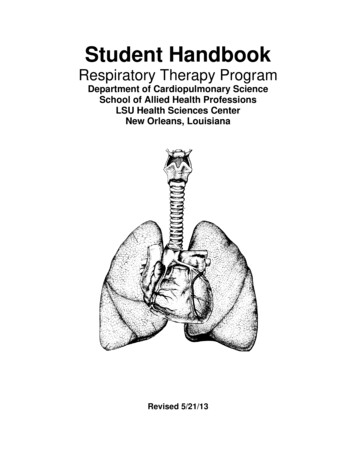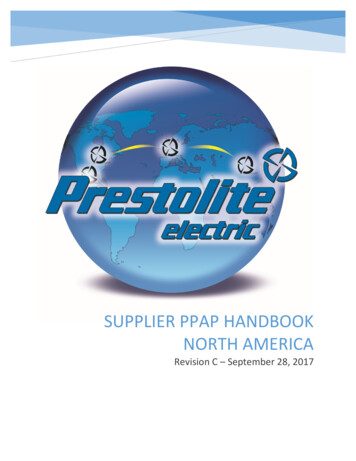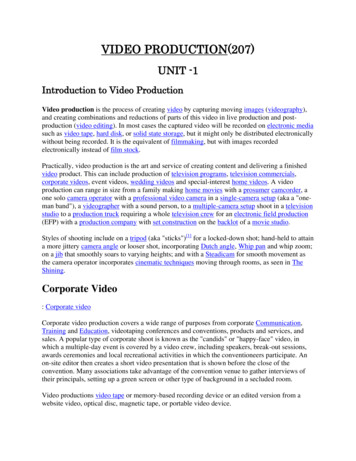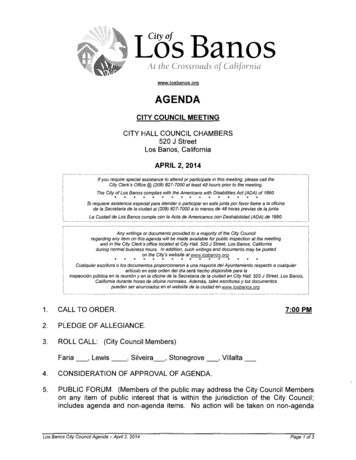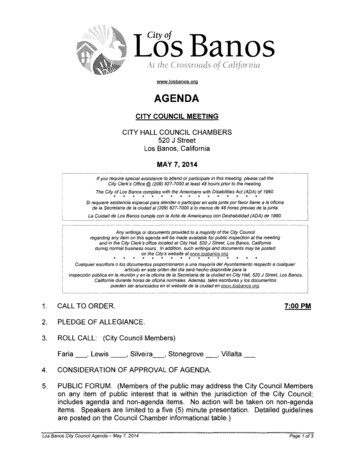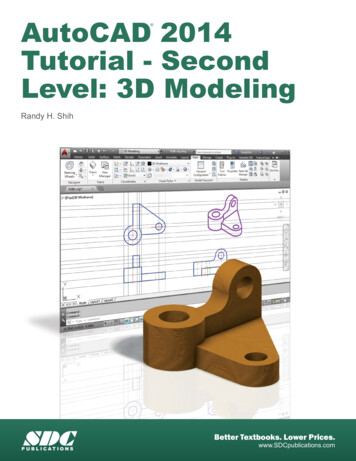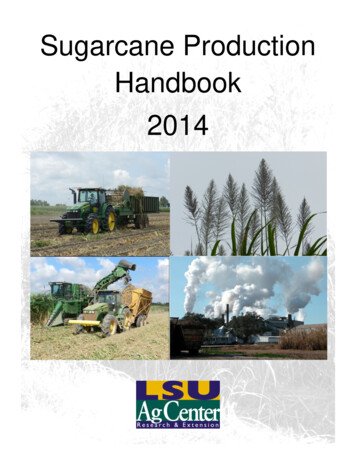
Transcription
Sugarcane ProductionHandbook2014
Table of ContentsSection ISugarcane planting recommendations for Louisiana sugarcane producers. 5Healthy seed cane . 5Variety recommendations for planting. 6Variety performance. 6Varieties recommended for planting . 8New variety release . 11Sugarcane variety survey . 11Planting recommendations and suggestions. 12Amount of soil cover over seed-cane . 14Depth of planting with relation to water furrow . 14Starter fertilizer application. 14Succession planting sugarcane (cane planted without fallow) . 15Suggested procedure for succession planting of sugarcane . 16Sugarcane Diseases . 17Section IIControlling weeds in sugarcane . 20At-planting weed control (August-September) . 20At-planting pre-emergence split application programs . 23Weed control in sugarcane harvested for seed and in-succession planted sugarcane . 24Residual control of winter weeds (October/November) . 25Post-emergence weed control (September-November) . 25Winter weed control (January-March) . 261 Page
Post-Emergence Weed Control (March-April) . 30Johnson Grass and other grasses (March/April) . 30Lay-By Weed Control (May-June) . 32After Lay-By Weed Control (July-Harvest) . 33Fallow weed control . 37Post-emergence fallow . 39Ditchbank weed control . 42Section IIISugarcane fertilization. 54Soil testing. 54Lime . 54Nitrogen. 55Nitrogen placement:. 55Split applications of nitrogen: . 55Sources of nitrogen: . 56Phosphorus and potassium . 56Phosphorus (P): . 56Potassium (K): . 57Sulphur (S): . 58Micronutrients . 59Fertilization at planting . 59Succession planted cane: . 59Conventionally planted cane: . 59Filter press mud: . 59Summary . 602 Page
Section IVSugarcane ripener recommendations . 61Glyphosate program . 61Moddus program . 64Section VDays to Harvest for POLADO Application October Harvest . 67Days to Harvest for POLADO Application November Harvest . 72Sugarcane harvesting recommendations including . 77Post-freeze resistance of varieties . 77Maturity classification . 77Post-freeze classification . 78Section VIInsect guide: commercial sugarcane . 79Sugarcane Borer . 80Mexican Rice Borer . 81Wireworms . 83Aphids . 833 Page
List of TablesTable 1: Combined means for plant-cane through third stubble crops across outfield locations . 7Table 2: Sugarcane variety characteristics . 10Table 3: Louisiana sugarcane variety trends by variety and year 2008-20121 . 12Table 4: Sugarcane diseases. 17Table 5: At-Planting Pre-Emergence (August/September) . 21Table 6: Sugarcane weed management . 23Table 7: Spring Weed Control (February/March). 28Table 8: Lay-By Weed Control (May/June) . 32Table 9: After Lay-By Weed Control (July/Harvest) . 34Table 10: Pre-Emergence Fallow. 38Table 11: Ditchbank Weed Control . 42Table 12: Effectiveness of Selected Sugarcane Herbicides Applied Pre-Emergence and Post-EmergenceIn-Crop and In-Fallow . 45Table 13: Pre-emergence application. 45Table 14: Glossary of Herbicides Registered for Use in Sugarcane in Louisiana1 . 47Table 15: Glyposate Products Registered for Use in Louisiana with Surfactant Recommendations . 50Table 16: Recommended Nitrogen Rates for Sugarcane in Louisiana . 55Table 17: Recommended Phosphate Rates for Sugarcane in Louisiana . 57Table 18: Recommended Potash Rates for Sugarcane in Louisiana . 58Table 19: Recommended Soil Levels for Sulphur in Sugarcane. . 59Table 20: Sugarcane Recommendation for the Application of Zinc in Louisiana . 594 Page
Sugarcane planting recommendations for Louisiana sugarcane producersThe success of a sugarcane farming operation depends on the ability to produce good standsof plant cane and maintain suitable stands for stubble crops. This section provides information tohelp growers make management decisions about planting practices that should result in excellentplant cane stands.Keeping good records is an essential part of wise decision making and management of asugarcane production operation. Growers are encouraged to keep good records of all plantingpractices as well as pest management practices.These recommendations are based primarily on research results. Where research results arenot available or are inconclusive, current farming practices are considered in makingsuggestions. The planting information does not include land preparation recommendations. It isessential that proper land preparation is carried out and that rows are built up and ready forfurrow opening. Recommendations are made on variety selection, furrow width, planting rate,weed control, soil insect control, depth of cover, depth of planting, dates of planting, successionplanting, and use of starter fertilizers.Healthy seed caneTo maximize yield potential for all sugarcane varieties, it is essential that plantings be madewith seed-cane that is free or nearly free of diseases. To accomplish this, healthy seed-canenurseries should be established with seed-cane of recommended varieties from a heat treatmentprogram or from seed-cane that has been produced by tissue culture to meet the requirements forcertification by the Louisiana Department of Agriculture and Forestry. Seed-cane nurseries of allvarieties expected to be grown should be planted with cane obtained from one of these sourcesevery year. Special care should then be taken to minimize infection of seed-cane by sugarcanepathogens.Ratoon stunting disease (RSD) will cause substantial yield losses in all of the varietiesrecommended for major planting. This disease can be controlled only by the continuous plantingof RSD-free seed-cane. In addition, RSD is spread mechanically, so equipment should becarefully cleaned before handling seed-cane. Since RSD has little or no visible symptoms, seedcane fields should be tested at the LSU AgCenter’s Sugarcane Disease Diagnostic Laboratory.Seed-cane should be propagated as few times as is economically feasible. A common mistakemade by growers is to assume that cane grown from heat-treated or certified seed-cane that hasbeen cut repeatedly is still disease free.Cane of any variety containing more than 2% smut-infected shoots should be avoided as aseed-cane source. Where practical, smut-infected plants should be rogued early in the seasonprior to the emergence of whips (sori). Avoid planting seed-cane nurseries of smut-susceptible5 Page
varieties next to smut-infected cane.Some recommended varieties are susceptible or moderately susceptible to leaf scald. Leafscald is transmitted through infected seed-cane, mechanically on equipment and, to some extent,in wind-blown rain. Care should be taken to plant healthy seed-cane. The heat treatment used tocontrol RSD does not cure stalks of leaf scald.Planting healthy seed-cane also means using cane for seed that has low levels of damagecaused by the sugarcane borer. Good sugarcane borer control helps to reduce damage by stalkrots following planting and helps to increase stands. Seed-cane nurseries of highly susceptiblevarieties, such as HoCP 00-950 and L 03-371, should not be planted where insecticides cannotbe applied, and cane to be used for seed should be monitored closely for borer presence.Variety recommendations for plantingVariety recommendations are based on results from research provided by the followingorganizations: LSU AgCenter; USDA-ARS, Sugarcane Research Unit; and the American SugarCane League. Variety development has been a long standing cooperative effort governed by theThree-way Agreement of 2007. Seven varieties, HoCP 96-540, L 99-226, HoCP 00-950, L 01283, L 01-299, L 03-371, and HoCP 04-838, are recommended for general planting in Louisiana.Other varieties such as LCP 85-384, HoCP 85-845, and CP 89-2143 have been successful insome situations. It must be stressed that growers should plant a variety only if a disease-free seedsource is available.Variety performanceThe means of multi-year outfield tests from plant cane through third-stubble crops providerelative yield information about the recommended varieties (Tables 1-4). Actual yields and therelative performance of the varieties on your farm may vary from those reported. Traits otherthan yield such as harvestability, insect and disease resistance must also be considered inchoosing a variety. Table 5 summarizes variety characteristics.6 Page
Table 1: Combined means for plant-cane through third stubble crops across outfield locations from 2009 to2012.Plant-CaneVarietySugar YieldCane YieldSugar ContentStalk oCP 96-540921633.32772.6325798L 99-226957632.72922.9022905HoCP 00-950963932.03012.2628790L 01-283915131.82882.1929371L 01-299912632.92772.2729725L 03-371996934.02942.4128840HoCP 04-838974635.32762.2631664First StubbleVarietySugar YieldCane YieldSugar ContentStalk oCP 96-540827830.12762.2327495L 99-226933031.32972.5325286HoCP 00-950833427.53051.8629767L 01-283918331.52921.9133571L 01-299975035.92761.9237747L 03-371890830.82902.1429036HoCP 04-838844330.62771.96316797 Page
Second StubbleVarietySugar YieldCane YieldSugar ContentStalk oCP 96-540646125.72571.7929434L 99-226746327.12792.1126195HoCP 00-950679523.92881.6629293L 01-283802329.62751.6037334L 01-299810331.22671.6139004L 03-371744927.62731.8330536HoCP 04-838680326.12651.6432135Third StubbleVarietySugar YieldCane YieldSugar ContentStalk oCP 96-540531120.82541.8422635L 99-226669024.42752.1023631HoCP 00-950678423.52911.6029962L 01-283766227.62791.5536206L 01-299791429.32701.6436783L 03-371669125.12661.8127896HoCP 04-838542721.22561.6526335Varieties recommended for plantingHoCP 96-540 was selected from a cross of LCP 86-454 x LCP 85-384 and released in2003. The variety responds extremely well to ripeners and has excellent post-freeze processingqualities. HoCP 96-540 is an erect variety that has withstood hurricane force winds well and isoften a choice for planting after such events. It is resistant to smut and leaf scald but issusceptible to RSD and brown rust. Research shows that HoCP 96-540 is moderately resistant tothe sugarcane borer. The variety has excellent yield potential and has been the leading sugarcanevariety in Louisiana since 2008.L 99-226 was selected from a cross of HoCP 89-846 x LCP 81-30 and was released in2006. L 99-226 is a high yielding, excellent stubbling variety. The variety produces a lowerpopulation of large diameter stalks and has high sugar per ton of cane. L 99-226 frequentlylodges and is difficult to plant. L 99-226 is susceptible to brown rust and is moderatelysusceptible to smut. The variety deteriorates quickly after being subjected to freezing8 Page
temperatures. The variety is moderately resistant to the sugarcane borer and is a good choice inareas where insecticides cannot be applied. L 99-226 responds well to the ripener glyphosate.HoCP 00-950 was selected from the cross HoCP 93-750 x HoCP 92-676 and wasreleased in 2007. This variety has the highest sugar per ton of any variety released by theLouisiana sugarcane breeding program. HoCP 00-950’s sugar per acre yield in plant-cane is verygood but there can be a decrease in stubble cane yields that cannot always be offset by high sugarper ton. HoCP 00-950’s best fit is on well drained sandier land and is a good choice whengrowers run out of ripened cane or on rainy days. This variety has a good disease package andhas performed well after freezes. The variety can have some top breakage in high winds.L 01-283 was selected from the cross between L 93-365 x LCP 85-384. When L 01-283was released in 2008, the new variety held much promise—good sugar per acre, erect, excellentstubbling ability and cold tolerance. However, off-types began appearing in the variety soonafter release. Yield trials have determined that high levels of off-types can decrease sugar peracre in L 01-283. The off-types are stress induced and normally begin to appear in July. Thevariety stubbles extremely well and early spring growth is impressive. At harvest, many fieldssugar yields have been good. The variety is susceptible to brown rust and the sugarcane borer. L01-283 should be planted on your better land to decrease stress induced off-types.L 01-299 was selected from the cross between L 93-365 x LCP 85-384. This variety hasa very erect growth habit and is an extremely good stubbling variety. L 01-299 has excellentsugar yields, especially in older stubble crops. Its sugar per ton levels is similar to HoCP 96-540.The variety is resistant to brown rust, but susceptible to brown stripe disease. L 01-299 issusceptible to smut and has resistance to the sugarcane borer and leaf scald. Because of itsstubbling ability, the variety should be a good fit on heavy land.L 03-371 is an offspring from the cross of CP 83-644 x LCP 82-89. L 03-371 is early anmaturing variety with high sugar per ton of cane. The variety is not erect and should be plantedearly before lodging. It is resistant to smut and leaf scald and moderately susceptible to brownrust. L 03-371 has a poor rating for post-freeze deterioration of the stalk. Research shows that L03-371 produces good sugar per acre yields, but is susceptible to the sugarcane borer. Thisvariety should not be planted where insecticides cannot be applied.HoCP 04-838 was selected from the cross HoCP 85-845 and LCP 85-384. This varietywas released to growers in 2011. HoCP 04-838 has a very good disease package in addition togood harvesting characteristics. The variety is also rated as resistant to the sugarcane borer,making it a good choice to plant where insecticide applications may be limited. HoCP 04-838has very good sugar yield potential. This new variety is most impressive in regard to freezetolerance. Position the variety for late harvest to take advantage of HoCP 04-838’s ability towithstand freezing temperatures.9 Page
Table 2: Sugarcane variety characteristicsCHARACTERISTICS FOR CURRENT COMMERCIAL SUGARCANE VARIETIESVarietal 1Sugar per acreVGVGGVGVGVGGSucrose Content GGGBorer resistanceSRSMRRSRRust resistanceSSMRMRMSRSmut resistanceRSRRSRRLeaf scald resistanceRMSMRRRRRPost-freeze deteriorationGP-MGGGPVGShadingMVGVGGMGGYear of ReleaseE EarlyR ResistantM Moderate, MediumMR Moderately ResistantG GoodMS Moderately SusceptibleVG Very GoodS SusceptibleP Poor10 P a g e
New variety releaseHo 05-961 was released in 2012. Because of low levels of sugarcane mosaic disease andnewly identified orange rust disease, the new variety was released but not distributed to growers.The disease situation in Ho 05-961 is being closely observed, and the variety is notrecommended for further expansion.Sugarcane variety surveyThe annual sugarcane variety census is conducted cooperatively by the LouisianaCooperative Extension Service and provides acreage data on variety plantings by growers. Abetter understanding of variety preference by growers can be seen in a comparison of severalyears of variety surveys. Table 6 shows the 2008-2012 variety survey results as compiled andreported by agricultural agents in the sugarcane-producing parishes of Louisiana.HoCP 96-540 continues as the most widely grown sugarcane variety in Louisiana, although itdecreased in acreage by four percentage points in 2012. The varieties L 99-226, HoCP 00-950,L 01-283, and L 01-299 increased in acreage from the previous year. All other varieties eitherdecreased or remained the same as reported from the previous year. L 99-226 was the secondmost widely grown variety followed by L 01-283, L 99-233, and L 01-299. All other varietiesare grown on only limited acreage.11 P a g e
Table 3: Louisiana sugarcane variety trends by variety and year 2008-20121Area planted to sugarcane by variety and years (%)Variety200820092010201120121 yr.ChangeLCP 85-3842261 1 10HoCP 85-8451 11110HoCP 96-5404450484339-4L 97-12817171162-4L 99-226511171921 2L 99-2332610119-2HoCP 00-95001246 2L 01-2830 1 1411 7L 01-2990 1 117 6L 03-37100 1 12 2HoCP 04-838000 11 1Others112110Totals1001001001001001Based on annual variety surveys by county agents, 2008-2012.Planting recommendations and suggestionsSelection of seed-cane: Growers should plant seed-cane that is as close to disease free aspossible. Cane that is growing well and is free of the sugarcane borer should be selected as seedcane. Healthy seed-cane will provide the best possible stands if adverse environmentalconditions such as drought, water logging or freezes occur. Mechanical planters should beoperating so as to minimize stalk damage.Stalk cold tolerance should be considered when selecting varieties, especially in the northernparishes. HoCP 96-540, L 01-283, L 01-299, and HoCP 04-838 have shown better stalk coldtolerance than other varieties.12 P a g e
Billet planting: Whole stalk planting will continue to be a recommended practice becauseresearch has shown that, over time, the highest yields will be obtained with the least risk byplanting whole stalks. However, when seed-cane is badly lodged, one option will likely be to cutand plant billets. Current varieties vary in tolerance of billet planting. Stand problems in billetplantings have been encountered most frequently with HoCP 96-540, L 99-226 and L 03-371.Plantings of whole stalks have out-yielded billet plantings in the plant-cane crop and somestubble crops in the majority of experiments.The impact of stalk rots is greater in billets because of their shorter length and the woundingthat occurs during cutting and planting. Billet plantings suffer greater damage if there is anykind of planting problem or environmental stress, and the risk of stand reduction is, therefore,greater. Because of greater stalk rot damage, billets possess less energy reserves than wholestalks by spring, and few buds remain to germinate and replace shoots killed by disease andadverse weather conditions.If you do choose to plant billets follow these practices:1. Plant longer (20-24 inch) billets,2. Remove every other slat in the elevator chain to accommodate longerbillets,3. Run the primary extractor fan but do not run the secondary extractor fan,4. Use a planting rate averaging at least six billets running in the plantingfurrow,5. Use good planting practices (good soil preparation and proper depth ofcover), and providing good drainage and careful weed control.Planting furrow width: Research has shown good yield increases in cane yield and sugaryield when the planted row was widened from the V-furrow to the 18-24 inch furrow. Based onthis research, it is suggested that growers use an 18-24 inch furrow for planting. It is alsosuggested that the furrow opener be constructed to leave a wide bottom with a slight indentationon each side of the furrow and a slight ridge of loose soil in the middle of the furrow bottom toaccommodate wider plantings.Planting rate: Based on research results and field observations, the planting raterecommendation is three to four stalks and a lap of at least two mature joints. Where sufficientseed-cane is not available for optimum planting rates, growers may be able to obtain acceptablestands by planting two stalks and a lap of at least two mature joints. These recommendations arebased on using high quality disease-free seed-cane. Additional seed-cane should be used tocompensate for poor quality seed-cane. Planted cane stalks should be spread to cover the entirewidth of the planting furrow.13 P a g e
Date of planting: Planting date trials from early August to mid-October have beenconducted across numerous years. Results have shown the greatest advantage of August overmid-October planting; in some trials August planting produced higher sugar yields than midSeptember plantings.Amount of soil cover over seed-caneResearch on depth of soil cover over seed-cane indicates that soil cover in excess of 4 inchescan cause yield losses even if the excess is removed in the spring following planting. Althoughlimited in acreages planted, heat-treated cane should be covered with 2 inches of packed soil.After the heat-treated cane is up to a good stand and before freezing weather occurs, add anadditional 2 inches of soil to protect from freeze damage. Do not cover heat-treated cane withmore than 2 inches of packed soil at planting.For August, September and October planting, cover with 3 to 4 inches of packed soil atplanting time. Farmers in the southern part of the belt can normally get by with 3 inches ofpacked soil covering. On farms in the northern part of the sugarcane belt, 4 inches of packed soilis recommended for additional freeze protection. Growers should use a fluke on the coveringtool to keep from covering with more than 4 inches of packed soil. Growers who cover withmuch more than 4 inches of packed soil should be prepared to remove the additional soil early inthe spring.Varieties such as L 01-299 and HoCP 96-540 have poor vigor when germinating afterplanting. Soil cover for these varieties should be no more than 3 inches of packed soil.Growers should use a covering tool that will cover the cane without pushing the cane closerthan the width it was planted. Packing of rows should be done immediately after covering tominimize air pockets. Clean quarter drains before spraying herbicides. Where soil washingoccurs in the fall before a hard freeze, it is suggested that the middles be sunk and rows rebuiltfor winter protection.Depth of planting with relation to water furrowTo avoid water damage, seed-cane should be placed at least 3 to 4 inches above the finalwater furrow or row middle. In soils with poor internal drainage, the seed-cane should be placedeven higher above the final water furrow when possible.Growers should be aware of the need to keep the seed-cane above the area where water levelswill hurt cane stands. Low row height at planting time could be a problem, especially with billetplanting.Starter fertilizer applicationRecent fertilization trials have shown sporadic yield responses to starter fertilizers applied inthe planting furrow for cane planted after a fallow year. Other research has shown better14 P a g e
response to starter fertilizer for succession planted cane. Where yield responses have beenobtained, the rate was an application of 15-45-45 lbs/A of N-P2O5-K2O.Based on these recent findings and high fertilizer prices, it is suggested that growers notapply starter fertilizer at planting. Where sugarcane is succession planted, a starter fertilizershould be applied at a rate of 15-45-45. Applying nitrogen at rates exceeding 15 lbs/A is notrecommended.Rotational soybean crops are becoming more common in fallow fields. Although a nitrogenfertilizer credit has not yet been established, the organic nitrogen from soybeans should besufficient to get the planted cane off to a good start in the fall. No starter fertilizer application isrecommended for cane planted after a soybean crop.Succession planting sugarcane (cane planted without fallow)Succession planting
To maximize yield potential for all sugarcane varieties, it is essential that plantings be made with seed-cane that is free or nearly free of diseases.




